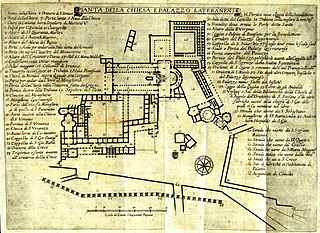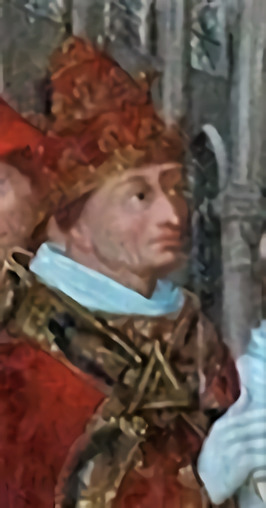Election of Lucius II
Pope Celestine II died on 8 March 1144 at Rome, after a pontificate of only five months. [1] The election of his successor took place in the shadow of this municipal revolution, which opposed the secular rule of the Pope. [2] Celestine II was unable to recover full control over the city of Rome; in addition he had to face also the demands of the king Roger II of Sicily. [3] This problem remained unresolved on his death, because he had refused to confirm the privileges granted to Roger by his predecessor Innocent II. [3]
The cardinals present at Rome elected Cardinal Gerardo Caccianemici, priest of the titulus of S. Croce in Gerusalemme and former canon regular of S. Frediano di Lucca. The details concerning the place of the election or the exact date of electoral proceedings are not registered. [4] Since the elect was chancellor of the Holy See and close collaborator of both Innocent II and Celestine II, it may be assumed that the cardinals wanted to continue their policy, friendly towards the Empire and hostile towards the king Roger. [5] The elect took the name Lucius II and received episcopal consecration on 12 March 1144. [6]

Pope Celestine II, born Guido di Castello, was head of the Catholic Church and ruler of the Papal States from 26 September 1143 to his death in 1144.
Boso was an Italian prelate and Cardinal of the Roman Catholic church.
Theodwin was a German cardinal and papal legate of the 12th century.
Jordan was a Carthusian monk, created Cardinal Deacon by Pope Lucius II in December 1144 and then Cardinal Priest of Santa Susanna by Eugene III on 21 December 1145. He is often referred to as a member of the Roman family of the Orsini, but more recent research concludes that he was probably a Frenchman. He served as Camerlengo of the Holy Roman Church under Eugene III and subscribed the papal bulls between 9 January 1145 and 11 June 1154.
Pandulf of Pisa was a twelfth-century Italian cardinal, and biographer of several contemporary popes. He was a native of Rome. He was a nephew of Cardinal Hugo of Alatri. Under Pope Paschal II, and probably with the patronage of his uncle, Pandulf held the post of ostiarius at the papal court. It is deduced from his detailed description of the election of Pope Gelasius II on 24 January 1118 that he was present. On his coronation day, 10 March 1118, Pope Gelasius II elevated him to the rank of Lector and Exorcist. Pope Calixtus II ordained him a subdeacon.
Ubaldo Caccianemici was an Italian cardinal and cardinal-nephew of Pope Lucius II, his cousin who elevated him in May or June 1144.
Gregorio della Suburra was an Italian cardinal, created by Pope Innocent II in 1140 as priest of the title of S. Maria in Trastevere. He was nephew of Pope Anastasius IV, who promoted him to suburbicarian see of Sabina in September 1154. After the double papal election in September 1159 he supported the obedience of Pope Alexander III. He became Dean of the Sacred College of Cardinals in 1159, after the deposition of Cardinal Icmar of Tusculum, who had consecrated Antipope Victor IV (1159-1164) and joined his obedience. He was papal vicar at Rome in 1160. His name appears for the last time in the papal bull dated 20 September 1162.
Imar, O.S.B. Cluny was a French Benedictine abbot, who served as a bishop and cardinal.

The papal election held from 4 to 7 September 1159 following the death of Pope Adrian IV resulted in the election of two rival candidates. A majority of the cardinals elected Cardinal Rolando of Siena as Pope Alexander III, but a minority refused to recognize him and elected their own candidate, Ottaviano de Monticelli, who took the name Victor IV, creating a schism that lasted until 1178.

The 1154 papal election followed the death of Pope Anastasius IV and resulted in the election of Pope Adrian IV, the only Englishman to become pope.
Guido de Summa was an Italian Cardinal.
The 1153 papal election followed the death of Pope Eugene III and resulted in the election of Pope Anastasius IV.

The 1143 papal election followed the death of Pope Innocent II and resulted in the election of Pope Celestine II.

The 1145 papal election followed the death of Pope Lucius II and resulted in the election of Pope Eugene III, the first pope of the Order of Cistercians.

The 1181 papal election followed the death of Pope Alexander III and resulted in the election of Pope Lucius III. This was the first papal election celebrated in accordance with the decree Licet de evitanda discordia, promulgated in the Third Lateran Council in 1179, which established that the pope is elected by a majority of two thirds votes.

Pope Eugene III (1145–1153) created sixteen cardinals in nine consistories:
Pope Lucius II (1144–1145) created eleven cardinals in two consistories.
Pope Celestine II (1143–1144) created nine cardinals in one consistory:
Saxo de Anagnia was a Roman Catholic Cardinal, and Cardinal-priest of the titulus of S. Stefano al Monte Celio in Rome. He was a native of Anagni, and a member of the family of the Conti di Anagni. Dumas points out that there is no positive evidence of the family connection.
This page is based on this
Wikipedia article Text is available under the
CC BY-SA 4.0 license; additional terms may apply.
Images, videos and audio are available under their respective licenses.






